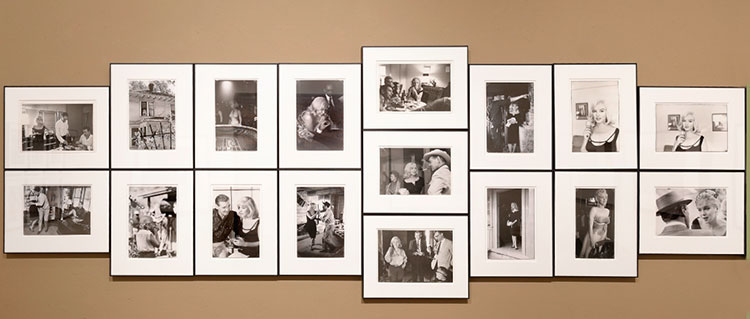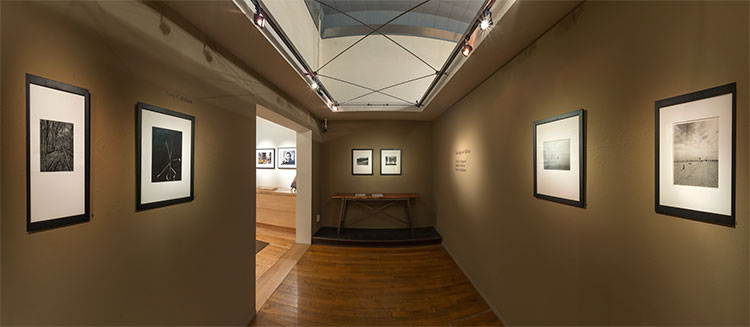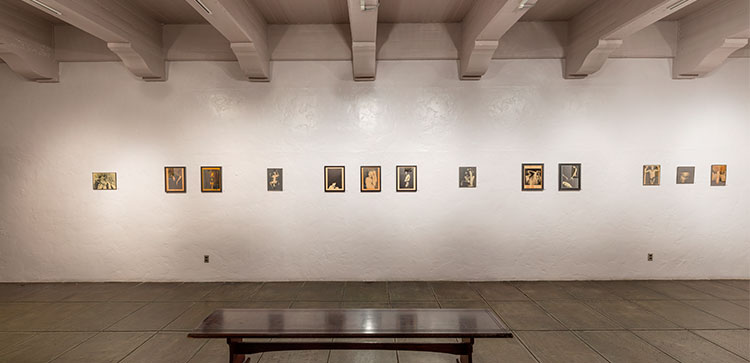Etherton Gallery's exhibition, Sightlines, features three photographers Jody Forster, Dick Arentz and Daniel Leivick who open up new vistas for our consideration. Sightlines presents landscape photography as a process whose technical evolution belies a shift in our understanding of the medium and its place in the world. Jody Forster's work embodies the aesthetics of pure photography signaled by the use of a view camera and darkroom processing. Master platinum printer Dick Arentz, has made the shift from the traditional craft of photography to the more open-ended processes of digital image making. Daniel Leivick explores 21st century cameraless photography using Google Maps, which seamlessly combines information from more than one source and presents it in a single graphical interface. The exhibition opens with an artist reception at 7-10pm, Saturday, March 12, 2016 and runs through June 4, 2016.
Sightlines presents a selection of recent work by photographer and intrepid outdoorsman Jody Forster. Forster is best known for making richly detailed photographs that capture the wide open spaces of the southwest by pointing his 8 x 10 inch view camera up and out towards the sky as in Hail Maker (2007). Romantic, magisterial views of the unpeopled and unspoilt West remind us of our insignificance in the world and aptly illustrate Carl Sagan's musings that, "Our posturings, our imagined self-importance, the delusion that we have some privileged position in the Universe, are challenged by this point of pale light." Like his mentor, Ansel Adams, Forster's great gift is his ability to use photography's "pale light" not only to inform but also to inspire. In Forster's clear-eyed views jagged peaks, classic natural landmarks and rough desert terrain far surpass any manmade achievements.
Now 80, Dick Arentz wrote the book on platinum printing. Literally. However, over the last few years he has experimented with digital technology to produce photographs that match or better the sharpness and subtle tonalities of traditional platinum printing. Sightlines features a series of photographs made in Scotland, an area rich in the historical imagination, using a Leica digital camera and a prime lens with a single focal length. Images such as Bus Stop, Ulst, Scotland (2005) speak in a quieter and exacting tone to Arentz's dedication to the formal aspects of digital image making. Like Forster, Arentz also uses the horizon to describe the land, but often includes evidence of a human presence such as a bus stop or a beached fishing boat, which he treats with the same elegance as his photographs of the imposing Wells Cathedral. Arentz's Scotland is more human-scaled and intimate. In his dream-like images man-made structures co-exist peacefully with the land.
Daniel Leivick constructs landscape photographs by combining or superimposing images of real places culled from Google Maps. Google Maps is a web mapping service that combines satellite, aerial and street level images into one interface. The street images are made using a camera with many lenses whose images are compressed and stitched together to create hi-resolution panoramas. However, Google may remove lewd graffiti and other information in response to security and/or privacy concerns. In the aptly named series, Heliopolis (City of Light), the name given to an ancient Egyptian city by its Greek occupiers, Leivick's photographs point to the always, already mediated nature of photography. He overlays Google Maps images to create large, square format, aerial photographs such as Circles (2014) that give the illusion of a sublime scientific accuracy. However, all attempts to locate and identify the repeating circular design are frustrated. The design is as reminiscent of ancient Nasca lines in Peru as it is a modern solar power installation in the Mojave Desert. Leivick's work suggests a new way of understanding photography as a condition or an experience woven into the social fabric.
Sightlines presents a selection of photography by three photographers that will give viewers a bird's eye view into the wide-ranging possibilities of landscape photography. At one end of the spectrum, it is process of representation and contemplation and at the other, in the hands of a new generation of photographers, it is a social practice about our mediated world.
BIOS
Jody Forster
Born in 1948 the son a career Air Force pilot, Jody Forster lived a military nomadic life-style from childhood through college, having lived in such places as, Alaska, Florida, Arizona, Germany, and California. He began his artist's life by drawing and painting from his experiences and observations of these places from the many outings with his father. Landscapes and birds were his favorite subjects. However, in college he switched to photography as his preferred medium of expression, graduating from Cal State at Los Angeles with a BA degree in photography in 1971. After graduating he attended an Ansel Adams Yosemite workshop to further his understanding of camera and darkroom techniques. In 1984 he joined on with the American Himalchuli Expedition to Nepal as team photographer. Afterwards, he continued to work with his 8x10 format camera in the high mountain sanctuaries of the Himalaya for another 7 months, at altitudes up to 18,000 feet.
Forster has been selected twice by the National Science Foundation to participate in the Antarctic Artists and Writers Programs in 1992 and again in 1995; having spent a total of six months on the icy continent working with his large format cameras. Forster currently resides in Mesa, Arizona as the light and the land of the Sonoran desert gives him his greatest inspiration.
Dick Arentz
In 1969 Dick Arentz began three years of study with Phil Davis of the Photography Department at the University of Michigan. His interest at that time was in the large format silver contact print. His informal "thesis," the Death Valley Portfolio (1972) was published in a 1973 issue of Camera Magazine.
After a sabbatical in Europe in 1973, Arentz relocated in Flagstaff, Arizona where he taught studio and photographic history at Northern Arizona University. In 1978, he was selected by the Arts and Humanities Commission as one of twenty Arizona artists to receive recognition. That year he began a six-year project, which was published as Four Corners Country in 1986, for which he received an Edna Rider Whiteman Foundation grant. Four Corners Country was reissued in soft cover in 1994.
He returned to Ann Arbor in 1980 to study the platinum process with Phil Davis. Almost immediately Arentz began researching and writing about platinum and palladium techniques, due to the scarcity of information and the unpredictability of the materials themselves. In 1983, he began to produce negatives with an antique 12×20 Folmer and Schwing Camera. By 1985, major museums and corporations had begun to collect his work. In 1987, he produced The American Southwest, a limited edition portfolio of 12×20 platinum prints with an essay by James Enyeart, former Director of the Center for Creative Photography.
In 1988, seeking a change, Arentz accepted An Isaac W. Bernheim Fellowship to live and work in Kentucky. He began a three-year project photographing the mid-southern states and Appalachia, concentrating on the human impact on the landscape. In 1990, the National Endowment for The Arts funded an exhibition at the Huntington Museum of Art and accompanying catalogue, Outside The Mainstream, with an introduction by Merry Foresta.
In 1990, Dick Arentz was one of four Arizona artists selected for the Phoenix Art Museum Triennial Exhibition. In 1992, he was included in Between Home And Heaven, Contemporary American Landscape Photographers, National Museum Of American Art. In England, During 1994-95, Arentz exhibited at the Fox-Talbot Museum and was included in the exhibition, A Positive View at the Saatchi Gallery. In 1996, he accepted a fellowship from the Columbus Art Museum to create a portfolio of central Ohio. In 1998, Nazraeli Press published a collection of his work from continental Europe, The Grand Tour, with an essay by Tom Southall, Curator of Photography at the High Museum. Another book from Nazraeli Press, The British Isles was published in 2001.
Arentz continued to publish and teach the techniques of platinum and palladium printing. As a result of his research, he was able to solve a problem that has plagued non-silver printers for years with the formulation of specifications to allow a major paper company to manufacture a paper suitable for these photographic processes. In 2000, he published the 1st edition of Platinum & Palladium Printing with Focal Press. In 2005, following research into the specific uses of sodium chloroplatinate (Na2) as a contrast control agent, Platinum & Palladium Printing was revised for a 2nd edition.
In 2000, having spent 35 years exposing film through the bellows of large format view cameras, Dick began to use the latest digital technology. In 2010 with the publication of Italy Through Another Lens Dick has moved to a new phase of his career, concentrating on images for publication and utilizing the Piezography method to make fine-art prints.
In a forty-year career, Dick Arentz has had over seventy-five one-man exhibits in museums and private galleries. Since 1984 has conducted over forty platinum printing workshops, included those at The Center For Creative Photography, The Museum Of Photographic Arts and The Friends Of Photography.
Daniel Leivick
Daniel Leivick is a photographer and digital artist originally from Santa Cruz, California. He received a BA in studio art from Stanford University and an MFA in photography from Arizona State University. His work, which focuses on human interaction with landscape and emergent phenomena, has been exhibited internationally, at institutions including the Art and Architecture Library at Stanford University; Sub Gallery in Stanford, CA; John Sommers Gallery in Albuquerque, NM; Northlight Gallery, Step Gallery, and Night Gallery in Tempe, AZ. Leivick was named a 2013 Photolucida Critical Mass Finalist and is the recipient of a Brooks Fellowship from Anderson Ranch, a John Schivley Fowler Award for Color Photography, an Irene Peggy Lamb Fellowship, a Herbert Smith Graduate Fellowship, and a Herberger Institute Student Enrichment Grant from Arizona State University. He currently lives and works in Los Angeles. |








